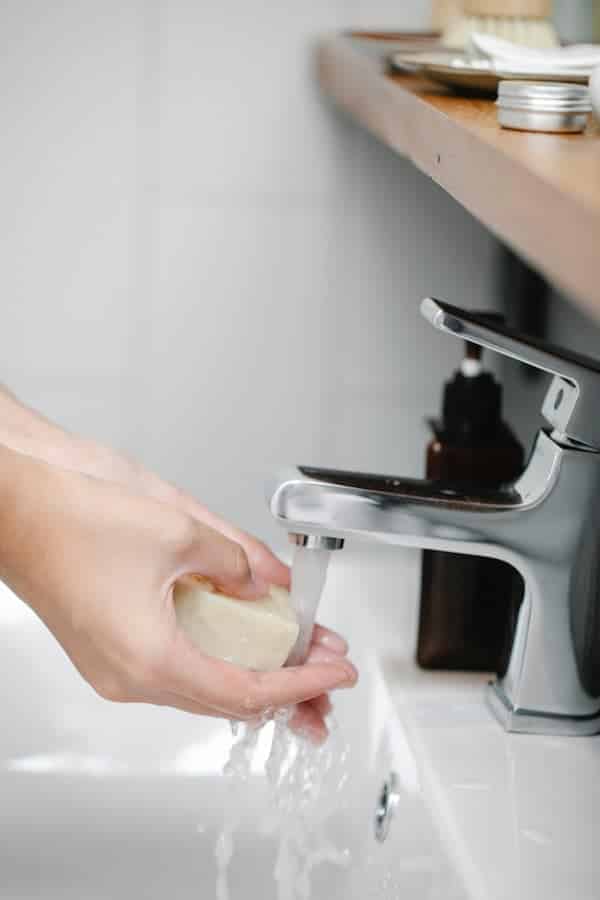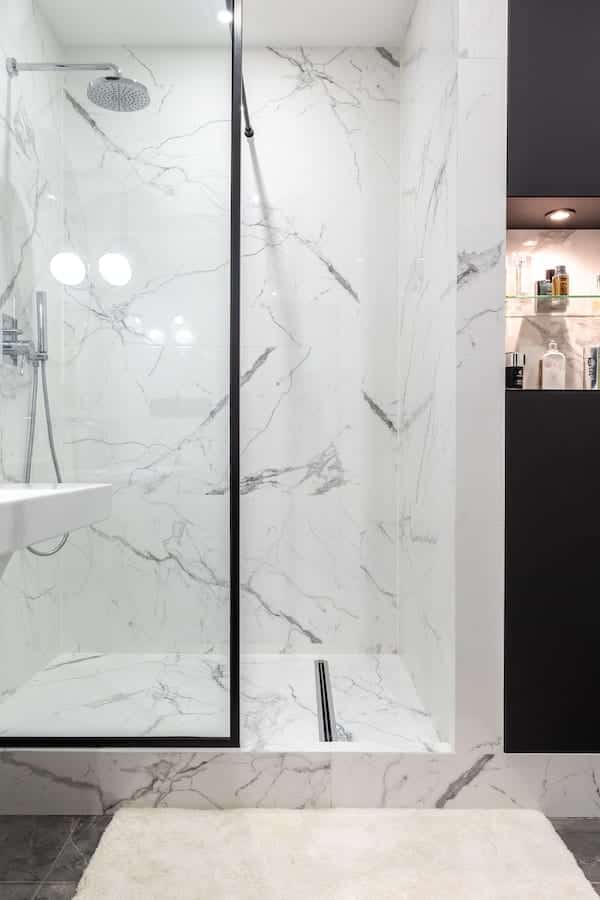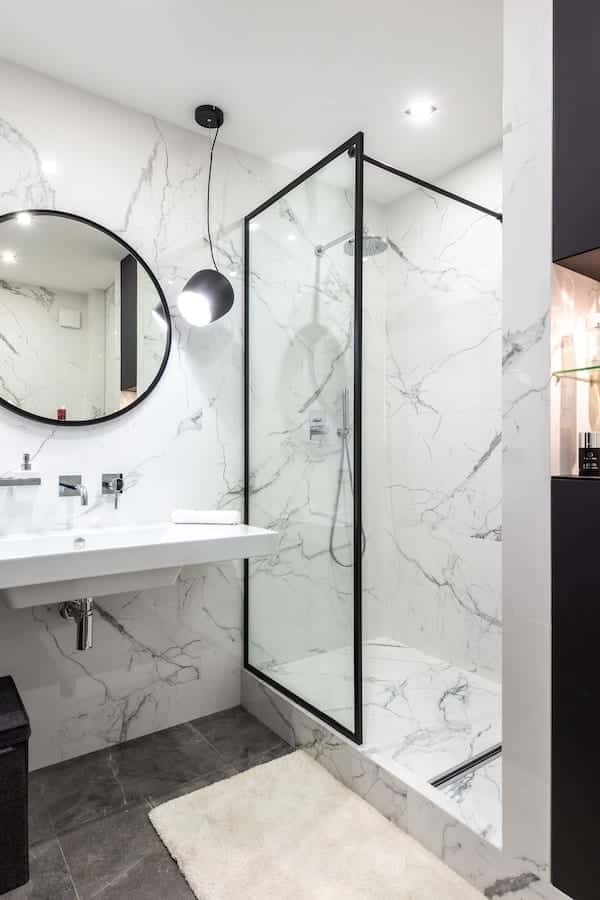Marble is a gorgeous rock that has been adapted for use in the home. Installing marble floors, counters, and walls can give your home a luxurious, bright, clean feel.
However, if the marble isn’t well maintained, it can have the opposite effect. The beautiful stone is resilient and long-lasting and can be a great investment piece for the home.
Marble is a pricey material that requires a little know-how to maintain its glamorous appearance. Cleaning marble is easy, and removing any excess water or contaminants from its surface will save you time in the long run.
Dry the shower after every use, and clean it with soapy water once a week. For more severe staining, using baking soda should do the trick. Keep reading to find out how.
There may be affiliate links in this article. You can read more about this in my disclosure.
Does Water Stain Marble?

Installing marble in your bathroom can seem like a great idea; it’s strong, water-resistant, and completely stunning. So, you may forget that water can penetrate the marble.
I know- we were surprised too!
Marble is highly porous, but the holes are so tiny you would never be able to tell. The holes on the surface are microscopic and allow water to seep into the marble.
The water travels deeper into the marble, dries, and creates staining. If the water is not cleaned regularly, it’s likely to create marks.
Water is, of course, the main element in question when cleaning bathrooms.
You would assume this is the most straightforward substance to deal with, as you’re not cleaning thick grease off a kitchen wall or restoring damaged wooden floors. But sadly, water can be an aggressive substance that can cause severe damage.
How Does Water Stain Marble?
Okay, now you have accepted the sad truth that your marble is not an impenetrable slab; it’s good to understand better how marble works.
Not only does water penetrate the marble’s hard exterior through the microscopic holes, but it also seeps in through the areas of imperfection. Naturally, through time, you will chip and scratch away at the marble’s surface, but unfortunately, these areas provide additional entry points for the water.
The water then dries, leaving behind minerals and salts. As these salt deposits build over time with repeat exposure, they will become more visible and unsightly.
If your house has hard water, this process will happen even quicker due to the higher volume of salts in the water.
Alternatively, rust-like stains can occur on marble. Finally, if the water comes into contact with heavy metals, the water stains can turn red, rust-like, or even green.
How Often Should I Clean My Marble Shower?

Ideally, you should be wiping down the marble shower after each use.
This will ensure excess water, oils, and product residue is removed and thus unable to penetrate the marble. This can take 2 seconds with the use of a squeegee.
However, you should give your marble shower a more thorough clean once weekly to remove any stubborn contaminants and prevent mildew and stains.
How To Clean Marble Shower with Dish Soap
Although removing excess water and contaminants after each shower use will keep your marble relatively clean, you should properly clean the shower once per week using soap.
For this method, you can create a soap solution that can be sprayed over the shower and washed away. Follow these steps:
Create the solution
Fill an empty spray bottle with warm water, add a squirt of a mild dishwashing liquid and shake to combine. Make sure you use a pH-neutral dish soap that doesn’t contain harsh or acidic cleaning chemicals like vinegar.
Spray and Clean
Liberally spray the solution all over the marble shower, starting from the top section and working your way down.
Wipe the surfaces thoroughly with a microfiber cloth, spending extra time cleaning the areas prone to stainings, such as those near the fixtures and the drain.
Rinse
If you have a handheld shower, use it to spray down the walls. Otherwise, grab a bucket of warm water and pour it all over the shower.
Ensure all traces of soap are washed away.
Dry
First, use a squeegee to remove excess water. Then using a dry microfiber cloth, dry and buff the surfaces until dry and shiny.
How to Clean Stains on Marble Shower
If your shower has been neglected and is showing some stains, a more rigorous method may be required. One of the best ways to clean stains from a marble shower is using a natural, at-home product.
Can you guess what it is? Baking soda!
Baking soda is a miracle ingredient usually used for making cakes and bread. However, it’s also excellent at cleaning.
Its alkaline properties make it naturally corrosive to grime and stains. It’s cheap, easy to use, and highly effective at cleaning marble.
It’s gentle enough that it won’t damage it but powerful enough to get the job done.
What you will need:
- A bowl.
- Baking soda.
- Water.
- Cloth x 2.
- Plastic wrap.
Follow these steps to remove stains from a marble shower using baking soda:
- Place one cup of baking soda into a large bowl and add just enough water to make a paste. The paste must be thick enough to stick to the walls, but not so thick that it won’t smear.
- Using a sponge or cloth, generously apply the waste to the stained area. Make sure the entire stain is covered in the solution.
- If possible, cover the area in plastic wrap. This retains heat and allows the baking soda to work in optimal conditions.
- Leave the solution to work for 12-24 hours. You cannot use the shower in the meantime, so plan ahead.
- After this time period, scrape the paste off with something gentle that won’t scratch the marble or wash it away with some water and a sponge.
This cleaning method should remove most stains from marble, but if it hasn’t, you can repeat the process or use the following procedure.
How to Remove Stains From Marble with Hydrogen Peroxide
This method should only be used as a backup option because hydrogen peroxide is a highly potent cleaning agent that can cause damage if not used correctly. So, if you’re given the baking soda method a shot and haven’t been met with any success, keep reading.
What you will need:
- Hydrogen peroxide.
- Latex gloves.
- A cloth.
- Cream of tartar.
- Water.
Follow these steps to remove stubborn stains from marble showers:
- Put on the latex gloves, and sprinkle the cream of tartar over the stain.
- Apply enough hydrogen peroxide over the stain to make a paste with the cream of tartar.
- Mix thoroughly with your hands (with gloves on) or an implement that won’t scratch the surface.
- Leave the mixture for 30 minutes. Put a timer on so that you don’t forget! The chemicals can damage the appearance of marble if left for too long.
- Wipe away the solution with a damp cloth.
- Thoroughly remove all residue from the area. Rinse and dry.
Tips to Keep Marble Showers Clean:

- Ensure the marble is adequately sealed. If water no longer beads on the surface, it’s a good indication the water is instead seeping into the marble, and it’s time to reseal. You can do this yourself with commercial sealant or hire a professional.
- Make sure your shower products do not contain acidic ingredients or dyes. Acid wears away marble and can quickly cause discoloration.
- Do not use cleaning tools that can scratch the marble, such as stiff-bristles brushes. Scratches can look innocent enough, but they remove the top layer of sealant and allow water to penetrate the marble.
- Dry or squeegee the marble after every use, especially if you have hard water. The minerals in hard water cause water staining.
- Don’t use harsh chemicals often, such as ammonia-based cleaners or chlorine bleach.
To Summarize
Stains on a marble shower are inevitable. The water comes into contact with the marble every day, as well as body oils and chemicals from your shower products.
However, with a little maintenance, your shower can look good for decades. Preventing is always easier than fixing, so try to squeegee the shower after each use and clean it properly with soap and water once per week.
Doing this will significantly reduce the chances of stains forming. But, if they do form, this guide will help you eradicate them in no time with a little baking soda or hydrogen peroxide.
Last update on 2024-04-23 / Affiliate links / Images from Amazon Product Advertising API











